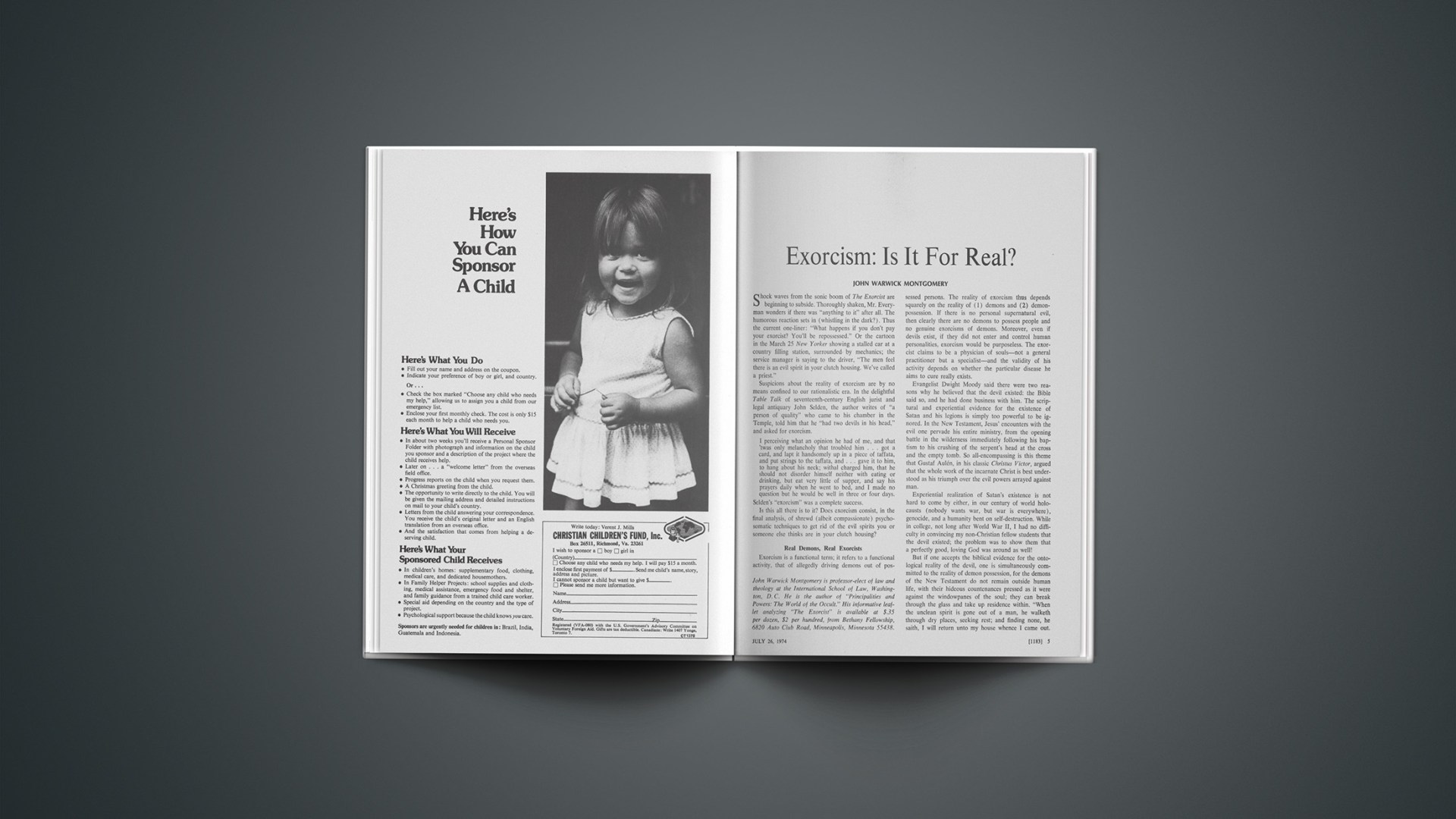Shock waves from the sonic boom of The Exorcist are beginning to subside. Thoroughly shaken, Mr. Everyman wonders if there was “anything to it” after all. The humorous reaction sets in (whistling in the dark?). Thus the current one-liner: “What happens if you don’t pay your exorcist? You’ll be repossessed.” Or the cartoon in the March 25 New Yorker showing a stalled car at a country filling station, surrounded by mechanics; the service manager is saying to the driver, “The men feel there is an evil spirit in your clutch housing. We’ve called a priest.”
Suspicions about the reality of exorcism are by no means confined to our rationalistic era. In the delightful Table Talk of seventeenth-century English jurist and legal antiquary John Selden, the author writes of “a person of quality” who came to his chamber in the Temple, told him that he “had two devils in his head,” and asked for exorcism.
I perceiving what an opinion he had of me, and that ‘twas only melancholy that troubled him … got a card, and lapt it handsomely up in a piece of taffata, and put strings to the taffata, and … gave it to him, to hang about his neck; withal charged him, that he should not disorder himself neither with eating or drinking, but eat very little of supper, and say his prayers daily when he went to bed, and I made no question but he would be well in three or four days.
Selden’s “exorcism” was a complete success.
Is this all there is to it? Does exorcism consist, in the final analysis, of shrewd (albeit compassionate) psychosomatic techniques to get rid of the evil spirits you or someone else thinks are in your clutch housing?
Real Demons, Real Exorcists
Exorcism is a functional term; it refers to a functional activity, that of allegedly driving demons out of possessed persons. The reality of exorcism thus depends squarely on the reality of (1) demons and (2) demonpossession. If there is no personal supernatural evil, then clearly there are no demons to possess people and no genuine exorcisms of demons. Moreover, even if devils exist, if they did not enter and control human personalities, exorcism would be purposeless. The exorcist claims to be a physician of souls—not a general practitioner but a specialist—and the validity of his activity depends on whether the particular disease he aims to cure really exists.
Evangelist Dwight Moody said there were two reasons why he believed that the devil existed: the Bible said so, and he had done business with him. The scriptural and experiential evidence for the existence of Satan and his legions is simply too powerful to be ignored. In the New Testament, Jesus’ encounters with the evil one pervade his entire ministry, from the opening battle in the wilderness immediately following his baptism to his crushing of the serpent’s head at the cross and the empty tomb. So all-encompassing is this theme that Gustaf Aulén, in his classic Christus Victor, argued that the whole work of the incarnate Christ is best understood as his triumph over the evil powers arrayed against man.
Experiential realization of Satan’s existence is not hard to come by either, in our century of world holocausts (nobody wants war, but war is everywhere), genocide, and a humanity bent on self-destruction. While in college, not long after World War II, I had no difficulty in convincing my non-Christian fellow students that the devil existed; the problem was to show them that a perfectly good, loving God was around as well!
But if one accepts the biblical evidence for the ontological reality of the devil, one is simultaneously committed to the reality of demon possession, for the demons of the New Testament do not remain outside human life, with their hideous countenances pressed as it were against the windowpanes of the soul; they can break through the glass and take up residence within. “When the unclean spirit is gone out of a man, he walketh through dry places, seeking rest; and finding none, he saith, I will return unto my house whence I came out. And when he cometh, he findeth it swept and garnished. Then goeth he, and taketh to him seven other spirits more wicked than himself; and they enter in, and dwell there: and the last state of that man is worse than the first” (Luke 11).
Furthermore, possession by demons is one of the most constant and universal religious phenomena, experientially confirmed among primitive peoples and civilized moderns alike, as the classical treatises on the subject fully attest (e.g., T. K. Oesterreich, Possession, Demoniacal and Other, among Primitive Races, in Antiquity, the Middle Ages, and Modern Times; Léon Cristiani, Evidence of Satan in the Modern World). And wherever there have been persons possessed by demons, there likewise have been exorcists (see Françoise Strachan, Casting out the Devils [London, 1972]).
Varieties Of Exorcistic Experience
The fact that the demonic and demon possession exist does not, to be sure, validate all exorcistic techniques—any more than the existence of cancer cells validates all supposed cures for the dread disease. What exorcistic methods have been common outside the Bible and within it?
Two major techniques have been characteristically employed by exorcists apart from the biblical tradition: casting out demons by numinous objects and by magical incantations. Hideous exorcistic rites among Tibetan Buddhists involve the use of such implements as the kangling, a trumpet made of a human femur (A. David-Neel, Magic and Mystery in Tibet, especially chap. iv). Taoist priests regularly employ charms and amulets, and among Muslims a particularly popular device is the amulet known as “the Hand of Fatima,” representing the holy family (the thumb symbolizes Muhammad the Prophet, the first finger his daughter Fatima, the middle finger Ali her husband, and the remaining fingers her two sons). Even more common as an exorcistic method, and invariably used along with magical objects, is incantation; thus among the ancient Babylonians and Assyrians, one technique involved the fastening of white and black yarn to the victim’s bed and the continual repetition of the line, “Spirit of heaven, mayest thou exorcise, spirit of earth, mayest thou exorcise” (T. G. Pinches, The Religion of Babylonia and Assyria, chap. v). Another such incantation declared: “By Marduk, chief exorciser of the gods, be exorcised! By the fire-god, who burns you, be exorcised! From my body be ye separated!”
In traditional Judaism (outside the canonical Scriptures) there is a parallel use of exorcistic objects and incantations. The Books of Jubilee says that an angel gave Noah secret herbs to control demons and that he passed this on to his eldest son Shem (10:10–14); also that Michael revealed a certain hidden name to be spoken for protection against demons (69:14–15). In Tobit the liver of a fish is burned with incense, and “the smell of the fish baffled the demon and he ran away into the upper parts of Egypt” (8:1–3). Rabbinic Judaism employed such incantations as the following: “To a demon one should say in order to drive him out: Be cursed, broken and banned, son of mud, son of the unclean, son of clay, in the name of Morigo, Moriphath and his Seal” (Strack-Billerbeck, Kommentar zum N. T. aus Talmud und Midrasch, IV, 532–33).
When we turn to New Testament exorcism, the comparison and contrast is most instructive. In the first place, there is no doubt whatever that Jesus believed in exorcism and practiced it. “And Jesus was casting out a devil, and it was dumb. And … when the devil was gone out, the dumb spake; and the people wondered. But some of them said, He casteth out devils through Beelzebub the chief of the devils.… But he, knowing their thoughts, said unto them, … If I by Beelzebub cast out devils, by whom do your sons cast them out?… But if I with the finger of God cast out devils, no doubt the kingdom of God is come upon you” (Luke 11). Writes Jean Lhermitte, the great neurologist and member of the French National Academy of Medicine, in his important work Vrais et faux possédés:
Whatever interpretation may be suggested of Jesus’ methods of treating the sick and the possessed, one thing is clear: our Lord always distinguishes the one from the other by applying a different spiritual “medication” to each. On the sick he lays his hands, he touches them, anoints them gently with his saliva; to the others he administers an exorcism. And it is this exorcism which he hands on to his disciples, and which they too will administer, wherever they are called to serve throughout the world [cf. Maurice Garcon and Jean Vinchon, The Devil: An Historical, Critical and Medical Study, Pt. II, chap. vi].
What exactly is the method of treatment that Jesus uniquely applies to the demon-possessed? As S. Vernon McCasland has stressed, it is not a “technique,” properly speaking; it is Jesus himself. That is to say, Jesus uses no exorcistic devices; he casts out demons by the power of his personal command (see McCasland, By the Finger of God: Demon Possession and Exorcism in Early Christianity). In sending out his disciples, Jesus gave them nothing but his exousia, his authority—nothing but himself: “He gave them authority over the unclean spirits; and he charged them that they should take nothing for their journey, save …” (Mark 6; Matt. 10; Luke 9). Thus the exorcisms performed by the apostolic company in the Book of Acts are done in a straightforward manner “in the name of Jesus Christ” (Acts 16:18). When the sons of Sceva come to grief as unbelievers in attempting to use the apostolic method, they offer excellent collateral evidence of what that method was: “I adjure thee by Jesus whom Paul preacheth” (Acts 19:13).
To be sure, as the sons of Sceva so humorously illustrate (if you don’t think the Bible has humor in it you haven’t read that incident!), the simplicity of exorcism in Jesus’ name is a deceptive simplicity: it requires proper spiritual preparation—first and foremost, a genuine belief-relationship with the Christ in whose name one speaks, and, beyond that, a sanctified life (Mark 9:29). In a word, New Testament exorcism is predicated on the theological foundations of justification and sanctification. Moreover, the exorcism of the New Testament is genuinely what the Germans call a Seelsorge—a eure of souls—as Jesus’ treatment of the Gadarene demoniac so clearly shows. This narrative (Matt. 8; Mark 5; Luke 8) is the sedes doctrinae for all Christian exorcistic practice and cannot be too closely studied. From it we see, among other things, how the exorcist is to identify demon possession by its characteristics (some of them physiological and psychological, like self-destructive tendencies; some peculiarly spiritual, like the manifestation of demonic personality traits), and how he must be aware of and put to good use the cosmic laws relative to the supernatural (e.g., what we might call “the law of conservation of demons,” the desire of demons to pass from one living thing to another on earth so as to delay their return to hell—a principle well understood and sensitively handled in the unjustly maligned Exorcist book and film). In a word, New Testament exorcism is indeed simple—for it has one simple focal center, Jesus himself, whose name alone subdues and conquers the evil powers; but it is not in any way simplistic, for it requires the mature application of Christ’s name to a peculiarly virulent spiritual disease.
Exorcism, Free-Wheeling Or Liturgical?
The patristic church saw clearly the radical distinction between Christian and non-Christian exorcism. One of the finest Statements of the Fathers is Origen’s:
It is not by incantations that Christians seem to prevail, but by the name of Jesus, accompanied by the proclamation of the narratives relating to Him; for the repetition of these has often been the means of driving demons out of men, especially when those who repeated them did so in a sound and genuinely believing spirit [Contra Celsum, I, vi].
At the same time, Christian believers soon began to incorporate exorcistic practice into the regular life of the church. Catechumens were being exorcised in preparation for baptism as early as the third century, when Cyprian reports it; the underlying idea was that the new converts had as pagans been subject to the “works” and “pomps” of the devil and were now to be freed of such control. In the case of infant baptism, the catechumen’s preparatory acts were combined into the baptismal liturgy, so that exorcism became an integral part of the rite of baptism (see L. Duchesne, Christian Worship: Its Origin and Evolution, 3d English ed., chap. ix). A minor order of exorcists developed in the Western church in the third century, and they often (though not exclusively) used rites collected in a book of exorcisms (Joseph Bingham, Antiquities of the Christian Church, Bk. III, chap. iv). Thus came into being the elaborate—Anglican Lowther Clark’s Liturgy and Worship rightly calls it “dramatic”—exorcistic rite of the Roman Ritual. Today, with the absorption of the minor order of exorcist into the major Orders, only bishops, or priests with episcopal license, can perform that liturgy (though there is always the possibility that just as the minor order of deacons has been recently revived, so the exorcists might be rehabilitated in the face of the current occult revolution!).
All this gives must Protestants a feeling just slightly less creepy than that produced by the idea of demon possession itself. The contrast could hardly be greater with the informal, ad hoc, spur-of-the moment variety of exorcisms described in, for example, the missionary accounts of the Moody Colportage Library’s Demon Experiences in Many Lands. In one such account, for example, “our Christian postmaster, my wife and I sang in the presence of the woman, ‘There’s power in the blood,’ ” and prayed. “As we prayed, the demon-possessed women would take words from our prayers and make ridiculous poems out of them.” The author of this account perceptively commented afterwards: “We learned that it is not enough to pray or to sing, though I believe that Satan hates both prayer and song. We must resist the devil and command that he depart.”
Granted, as the Protestant Augsburg Confession so well puts it, “it is not necessary that human traditions, rites, or ceremonies instituted by men, should everywhere be the same” (Art. VII: “Of the Church”). But in our zeal to discard the unscriptural in the traditions of the Church, we easily go to the other extreme, and fall uncritically to the merey of the individualistic, personalistic, experience-centered tradition of modern evangelical church life! Thus we throw out baby with the bath water: the great insights of Christian believers who fought the good fight—along with the doctrinal aberrations of false teachers.
In Mark 9:29 we see the disciples unable to cast out a particularly tenacious demon. Said Jesus: “This kind can come out by nothing save by prayer” (substantially all manuscripts except Aleph and B add “and by fasting”). McCasland, a Protestant who by no means believes in the inerrancy of the biblical text, sees in this passage evidence that Jesus’ “simple [exorcistic] procedure early began to be expanded.” But is not this “expansion” (occurring right in the Scripture itself) what one should expect? This is nothing more than an outworking of the implications of exorcism in Jesus’ name. The great exorcistic rites of the historic church purport to be nothing more, and at their best are nothing more, than consistent elaborations of the New Testament teaching that demons can be cast out only in the “name that is above every name.”
Luther had no objection to the inclusion of exorcism in the baptismal rite, and it was a part of his own scriptural revision of that liturgy in 1523 and 1526. “In the rationalistic period at the end of the eighteenth century, it finally disappeared from one service-book after another, and now, since its general abandonment by the Lutherans, the ceremony has no place in the rites of any Protestant Church” (Kawerau, in the PRE and New Schaff-Herzog). This is unfortunate, for even the exorcistic liturgy in the Roman Ritual is fundamentally scriptural and has much to offer to the Protestant concerned with these matters. Its use of the Bible is most instructive: stress is placed upon the Psalms (3; 10; 12; 21; 30; 34; 53; 67), on the Luke 11 passage I quoted earlier, and on the Lucan material in the preceding chapter (10:17–20), which could serve as the exorcist’s text of texts: “And the seventy returned again with joy, saying, Lord, even the devils are subject unto us through thy name. And he said unto them, I beheld Satan as lightning fall from heaven. Notwithstanding, in this rejoice not, that the spirits are subject unto you; but rather rejoice, because your names are written in heaven.” Quite properly, the Roman rite of exorcism uses the Athanasian Creed—that longest and most christologically detailed of the three ecumenical creeds; the implication is that nothing causes the devils to tremble like the trinitarian verities and right doctrine: “the true Christian faith: which except one believe it faithfully, he cannot be saved.”
For those who feel uncomfortable with the Roman Ritual—and also for those who don’t!—a recent Anglican publication is indispensable: Exorcism: The Report of a Commission Convened by the Bishop of Exeter, edited by Dom Robert Petitpierre (London: SPCK, 1972). The commission provides simple, sane, and straightforward guidelines for exorcistic practice, based on historic church tradition and requiring only minor modifications to accord quite thoroughly with biblical teaching. Here is a stalwart example of the exorcistic prayers to be found in this little volume:
O Holy Lord, Almighty Father, who has sent your only-begotten Son into the world that He might destroy the works of the devil, speedily hear us we pray you. Grant strength to your servants to fight valiantly against the evil one. May the strength of your right hand make Satan loose thy servant N., so that he no longer dares to hold captive him whom you have made in your image and redeemed in your Son: who lives and reigns with you in the unity of the Holy Spirit, world without end. Amen.
This fine prayer rightly asks that strength be given to God’s servants “to fight valiantly against the evil one.” Whatever the forms employed in exorcism, everything must focus upon the power and strength of Christ. An exorcist, no matter how sound in doctrine and sanctified in life, is no personal match for supernatural evil. Just as some witnessing battles are lost while others are won, so some exorcisms succeed while others do not. The maturity of The Exorcist as book and film was nowhere better demonstrated than in its recognition that in the last analysis, where all else fails, only Substitution rids man of the evil powers arrayed against him. Thus the final appeal must always be made to the Great Substitute, who on the cross, “having spoiled principalities and powers, made a shew of them openly, triumphing over them in it” (Col. 2:14, 15). There and there alone we have an Exorcist who (thank God!) does not need to be paid to prevent repossession. What he did for us can never be repaid. And one day even our failures will be redeemed, for from the heights of heaven to the lowest depths of hell every knee shall bow and every tongue confess that Jesus Christ is Lord.










